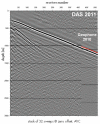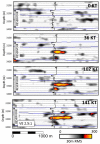Seismic Applications of Downhole DAS
- PMID: 33919095
- PMCID: PMC8122346
- DOI: 10.3390/s21092897
Seismic Applications of Downhole DAS
Abstract
Distributed Acoustic Sensing (DAS) is gaining vast popularity in the industrial and academic sectors for a variety of studies. Its spatial and temporal resolution is ever helpful, but one of the primary benefits of DAS is the ability to install fibers in boreholes and record seismic signals in depth. With minimal operational disruption, a continuous sampling along the trajectory of the borehole is made possible. Such resolution is highly challenging to obtain with conventional downhole tools. This review article summarizes different seismic uses, passive and active, of downhole DAS. We emphasize current DAS limitations and potential ways to overcome them.
Keywords: DAS; distributed; downhole; exploration; seismic; seismology.
Conflict of interest statement
The authors declare no conflict of interest.
Figures













Similar articles
-
Seismic Monitoring of a Deep Geothermal Field in Munich (Germany) Using Borehole Distributed Acoustic Sensing.Sensors (Basel). 2024 May 11;24(10):3061. doi: 10.3390/s24103061. Sensors (Basel). 2024. PMID: 38793919 Free PMC article.
-
3D DAS VSP for Coal Seam Exploration: A Case Study from Queensland, Australia.Sensors (Basel). 2024 Apr 17;24(8):2561. doi: 10.3390/s24082561. Sensors (Basel). 2024. PMID: 38676178 Free PMC article.
-
The Effect of the Method of Downhole Deployment on Distributed Acoustic Sensor Measurements: Field Experiments and Numerical Simulations.Sensors (Basel). 2023 Aug 29;23(17):7501. doi: 10.3390/s23177501. Sensors (Basel). 2023. PMID: 37687957 Free PMC article.
-
Sensing Shallow Structure and Traffic Noise with Fiber-optic Internet Cables in an Urban Area.Surv Geophys. 2021;42(6):1401-1423. doi: 10.1007/s10712-021-09678-w. Epub 2021 Nov 19. Surv Geophys. 2021. PMID: 34815609 Free PMC article. Review.
-
Recent Progress in Distributed Fiber Acoustic Sensing with Φ-OTDR.Sensors (Basel). 2020 Nov 18;20(22):6594. doi: 10.3390/s20226594. Sensors (Basel). 2020. PMID: 33218051 Free PMC article. Review.
Cited by
-
Long Range Raman-Amplified Distributed Acoustic Sensor Based on Spontaneous Brillouin Scattering for Large Strain Sensing.Sensors (Basel). 2022 Mar 6;22(5):2047. doi: 10.3390/s22052047. Sensors (Basel). 2022. PMID: 35271194 Free PMC article.
-
Seismic Monitoring of a Deep Geothermal Field in Munich (Germany) Using Borehole Distributed Acoustic Sensing.Sensors (Basel). 2024 May 11;24(10):3061. doi: 10.3390/s24103061. Sensors (Basel). 2024. PMID: 38793919 Free PMC article.
-
Monitoring underwater volcano degassing using fiber-optic sensing.Sci Rep. 2024 Feb 7;14(1):3128. doi: 10.1038/s41598-024-53444-y. Sci Rep. 2024. PMID: 38326378 Free PMC article.
-
Deep Neural Networks for Detection and Location of Microseismic Events and Velocity Model Inversion from Microseismic Data Acquired by Distributed Acoustic Sensing Array.Sensors (Basel). 2021 Oct 5;21(19):6627. doi: 10.3390/s21196627. Sensors (Basel). 2021. PMID: 34640947 Free PMC article.
-
Frequency Seismic Response for EEWS Testing on Uniaxial Shaking Table.Entropy (Basel). 2023 Apr 14;25(4):655. doi: 10.3390/e25040655. Entropy (Basel). 2023. PMID: 37190443 Free PMC article.
References
-
- Rost S., Thomas C. Array seismology: Methods and applications. Rev. Geophys. 2002;40 doi: 10.1029/2000RG000100. - DOI
-
- Yilmaz Ö. Seismic Data Analysis. Society of Exploration Geophysicists; Tulsa, OK, USA: 2001.
-
- Wang Y. Seismic Inversion: Theory and Applications. John Wiley & Sons; Hoboken, NJ, USA: 2016.
-
- Balch A.H., Lee M.W., Miller J.J., Ryder R.T. The use of vertical seismic profiles in seismic investigations of the earth. Geophysics. 1982;47:906–918. doi: 10.1190/1.1441357. - DOI
-
- Maxwell S. Microseismic Imaging of Hydraulic Fracturing: Improved Engineering of Unconventional Shale Reservoirs. Society of Exploration Geophysicists; Denver, CO, USA: 2014.
Publication types
LinkOut - more resources
Full Text Sources
Other Literature Sources

